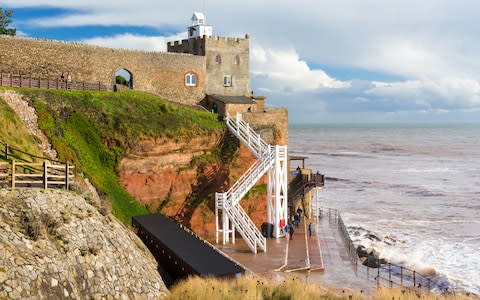The British seaside town with a dark, smelly secret

Once known principally for being a scenically becliffed Regency seaside town with a folk festival, Sidmouth in Devon is now enduring a period of notoriety, infamy even, thanks to its occupation, or infestation, by a giant specimen (210ft – “longer than the height of the Leaning Tower of Pisa”, jabbered The New York Times) of the squalid parasite we know as a fatberg.
The town and its fatberg find their destiny bound together, congealing into oneness like the miscellaneous urban detritus from which the Sidmouth Fatberg, as experts are prosaically calling it, is made.
It is normal to be anxious about this; it is normal to be afraid. But there is nothing you or I can do about this prodigious emissary of hell, lurking beneath the town’s long and lovely esplanade, mute and massive and, according to recent reports, beginning to niff a bit (“rotting meat mixed with the odour of a toilet,” commented a seasoned fatberg wrangler from Thames Water) – nothing, that is, besides wishing the best of British luck to the brave men and women of South West Water, who will soon begin their Manichean tussle with this rough beast. (“Alongside high-pressure jets and specialist equipment, our sewer workers will endure weeks of manual labour, attacking the fatberg bit by bit with shovels and pickaxes.”)
Given the circs, it seems trite to discuss Sidmouth as a daytripping destination, but I suppose I shall have to hold my nose. Speaking of which, it turns out you can’t actually smell the fatberg from the esplanade, which, depending on your opinion of fatbergs – vile-smelling, not-funny nuisance, or overall civic good on the grounds of hilarity? I for one have made my mind up – may or may not be a Good Thing.
Nor can you even see the thing. Worse, the temporary information booth set up by South West Water had been dismantled the day before I arrived. The sea air was fresh; light danced on the waves; pensioners strolled past pastel-coloured houses. Sidmouth was a vision of tranquillity. Which was extremely disappointing.

If you find yourself thus frustrated in Sidmouth, know that there are other things you can do with your time there. The South West Coast Path runs along the seafront: follow it westward, and you’ll walk beneath striking red cliffs formed 240 million years ago.
It’s not far to Jacob’s Ladder, a cliff-mounted staircase that leads to the Cakery on the summit. From here you can look down on a shingly beach, or continue into the municipal gardens and to another vantage point, from which you can see thatched houses to your left and the slope of the hill back down to Sidmouth.
What a pretty town, you might catch yourself thinking: what a long and lovely esplanade. But beneath it, the fatberg lies, waiting. That’s what it does. May God have mercy on us all.

The cakery
Make it to the top of Jacob’s Ladder – it’s not far – and you can reward yourself with one of the enormous, Bruce Bogtrotter-luring slices of cake at The Clock Tower Cakery & Restaurant.
The observatory
The Norman Lockyer Observatory, which is a short drive from the town centre, isn’t open day-to-day, but has telescope viewings and open evenings from time to time (normanlockyer.com).
The gardens
The Connaught Gardens aren’t at their liveliest just now but they are home to the Sidmouth Fiddler, commissioned in 2005 to celebrate 50 years of the folk festival.
The donkeys
There’s a well-maintained donkey sanctuary, home to 500 of the beasts, near Sidmouth (thedonkeysanctuary.org.uk/visit-us/sidmouth).
The café
The Fort Café and Restaurant, which is on the esplanade, has panoramic views of the beach and cliffs, and serves both hot food and ice cream.
